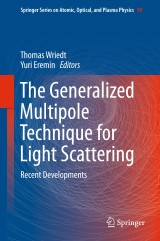Details

The Generalized Multipole Technique for Light Scattering
Recent DevelopmentsSpringer Series on Atomic, Optical, and Plasma Physics, Band 99
|
CHF 153.50 |
|
| Verlag: | Springer |
| Format: | |
| Veröffentl.: | 09.03.2018 |
| ISBN/EAN: | 9783319748900 |
| Sprache: | englisch |
Dieses eBook enthält ein Wasserzeichen.
Beschreibungen
<p>This book presents the Generalized Multipole Technique as a fast and powerful theoretical and computation tool to simulate light scattering by nonspherical particles. It also demonstrates the considerable potential of the method.</p> In recent years, the concept has been applied in new fields, such as simulation of electron energy loss spectroscopy and has been used to extend other methods, like the null-field method, making it more widely applicable. The authors discuss particular implementations of the GMT methods, such as the Discrete Sources Method (DSM), Multiple Multipole Program (MMP), the Method of Auxiliary Sources (MAS), the Filamentary Current Method (FCM), the Method of Fictitious Sources (MFS) and the Null-Field Method with Discrete Sources (NFM-DS). The Generalized Multipole Technique is a surface-based method to find the solution of a boundary-value problem for a given differential equation by expanding the fields in terms of fundamental or other singular solutions of this equation. The amplitudes of these fundamental solutions are determined from the boundary condition at the particle surface.<p></p> <p>Electromagnetic and light scattering by particles or systems of particles has been the subject of intense research in various scientific and engineering fields, including astronomy, optics, meteorology, remote sensing, optical particle sizing and electromagnetics, which has led to the development of a large number of modelling methods based on the Generalized Multipole Technique for quantitative evaluation of electromagnetic scattering by particles of various shapes and compositions. The book describes these methods in detail.</p>
<p>Principal Modes of Maxwell’s Equations.- The Invariant Imbedding T Matrix Approach.- Methods for Electromagnetic Scattering by Large Axisymmetric Particles with Extreme Geometries.- Fictitious Particle Approach for Light Scattering Investigation from the Line Features of a Substrate Based on the Discrete Sources Method.- Convergent Fields Generated by Divergent Currents in the Method of Auxiliary Sources.<br></p>
<p>Thomas Wriedt studied Electrical Engineering in Kiel and Bremen, Germany. He received his Dr.-Ing. degree in Microwave Engineering from the University of Bremen in 1986. From 1986 to 1989 he was a postdoc researcher at the University of Bremen's Department of Process Engineering, working on optical particle characterization. He has been the head of the Powder and Particle Measurement research group at the Stiftung Institut für Werkstofftechnik (IWT) (from January 2018: Leibniz-Institut für Werkstofforientierte Technologien (IWT) ), Bremen since 1989. His current research focuses on the Null-field method with Discrete Sources (NFM-DS) for simulation in optical particle characterization and generally light scattering by particles. He has authored and co-authored four books and 170 peer-reviewed papers.</p> Yuri A. Eremin graduated from the Physics Faculty of Lomonosov Moscow State University (MSU), Russia in 1972. He received his Ph.D. in Mathematical and Theoretical Physics from Lomonosov Moscow State University (MSU) in 1976. From 1975 to 1982 he was a research scientist at the Research Computing Center (RCC) of MSU. From 1982 to 1992 he was a senior researcher at the Computational Mathematics and Cybernetics Faculty of MSU. He obtained his Dr. Sci. degree in Mathematical Modeling from MSU in 1989. Since 1993 he has been the head of a research group at the Computational Mathematics and Cybernetics Faculty of MSU. His current interests are direct and inverse light scattering problems. He is the author of the Discrete Sources Method that enables the construction of effective computational models to simulate light scattering. He has authored more than 215 papers in scientific journals and four books.<p></p>
<p>This book presents the Generalized Multipole Technique as a fast and powerful theoretical and computation tool to simulate light scattering by nonspherical particles. It also demonstrates the considerable potential of the method.</p>In recent years, the concept has been applied in new fields, such as simulation of electron energy loss spectroscopy and has been used to extend other methods, like the null-field method, making it more widely applicable. The authors discuss particular implementations of the GMT methods, such as the Discrete Sources Method (DSM), Multiple Multipole Program (MMP), the Method of Auxiliary Sources (MAS), the Filamentary Current Method (FCM), the Method of Fictitious Sources (MFS) and the Null-Field Method with Discrete Sources (NFM-DS). The Generalized Multipole Technique is a surface-based method to find the solution of a boundary-value problem for a given differential equation by expanding the fields in terms of fundamental or other singular solutions ofthis equation. The amplitudes of these fundamental solutions are determined from the boundary condition at the particle surface.<p></p><p>Electromagnetic and light scattering by particles or systems of particles has been the subject of intense research in various scientific and engineering fields, including astronomy, optics, meteorology, remote sensing, optical particle sizing and electromagnetics, which has led to the development of a large number of modelling methods based on the Generalized Multipole Technique for quantitative evaluation of electromagnetic scattering by particles of various shapes and compositions. The book describes these methods in detail.</p>
Provides an overview of latest developments in electromagnetic and light scattering theories Describes a broad range of applications of generalized multipole technique Presents the science of plasmonic particles
<p><br></p>
Diese Produkte könnten Sie auch interessieren:

Introduction to Focused Ion Beams

von: Lucille A. Giannuzzi, Lucille A. North Carolina State University

CHF 153.50















